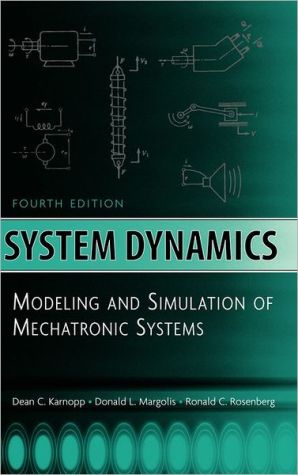System Dynamics
A revision of the bestselling system dynamics book using the bond graph approach\ System Dynamics is a cornerstone resource for engineers faced with the evermore-complex job of designing mechatronic systems involving any number of electrical, mechanical, hydraulic, pneumatic, thermal, and magnetic subsystems. This updated Fourth Edition offers the latest coverage on one of the most important design tools today-bond graph modeling-the powerful, unified graphic modeling language.\ The only...
Search in google:
A revision of the bestselling system dynamics book using the bond graph approach System Dynamics is a cornerstone resource for engineers faced with the evermore-complex job of designing mechatronic systems involving any number of electrical, mechanical, hydraulic, pneumatic, thermal, and magnetic subsystems. This updated Fourth Edition offers the latest coverage on one of the most important design tools today-bond graph modeling-the powerful, unified graphic modeling language. The only comprehensive guide to modeling, designing, simulating, and analyzing dynamic systems comprising a variety of technologies and energy domains, System Dynamics, Fourth Edition continues the previous edition's step-by-step approach to creating dynamic models. The first six chapters have been improved to make the material much more understandable for those unfamiliar with physical system modeling. The presentation starts with the basic elements and leads to sophisticated mathematical models suitable for automated computer simulation. The new edition incorporates the authors' vast experience in teaching the topics to undergraduate and graduate students over many years and features expanded coverage of topics including: * New expositions of modeling methods for electrical, mechanical, and hydraulic systems * New sections on mechanical systems in plane and three-dimensional motion * New sections on hydraulic and acoustic systems This Fourth Edition continues to stress all the essentials-from basic hand formulation of simple bond graph models to the automatic simulation of complex mechatronic systems. It offers updated examples of multi-energy domain systems aswell as: * Discussions of state-of-the-art simulation software for use with bond graph models * Presentations of a multiport modeling philosophy based on power and energy interactions * Methods for understanding system characteristics and predicting system behaviors * The use of graphical depictions of dynamic systems that can be translated automatically into complex mathematical models for computer simulation
System Dynamics\ \ By Dean C. Karnopp \ John Wiley & Sons\ ISBN: 0-471-70965-4 \ \ \ Chapter One\ INTRODUCTION \ This book is concerned with the development of an understanding of the dynamic physical systems that engineers are called upon to design. The type of systems to be studied can be described by the term mechatronic, which implies that while the elements of the system are mechanical in a general sense, electronic control will also be involved. For the design of a computer-controlled system, it is crucial that the dynamics of systems that exchange power and energy in various forms be thoroughly understood. Methods for modeling real systems will be presented, ways of analyzing systems in order to shed light on system behavior will be shown, and techniques for using computers to simulate the dynamic response of systems to external stimuli will be developed. Before beginning the study of physical systems, it is worthwhile to reflect a moment on the nature of the discipline that is usually called system dynamics in engineering.\ The word system is used so often and so loosely to describe a variety of concepts that it is hard to give a meaningful definition of the word or even to see the basic concept that unites its diverse meanings. When the word system is used in this book, two basic assumptions are being made:\ 1. A system is assumed to be an entity separable from the rest of the universe (the environment of the system) by means of a physical or conceptual boundary. An animal, for example, can be thought of as a system that reacts to its environment (the temperature of the air, for example) and that interchanges energy and information with its environment. In this case the boundary is physical or spatial. An air traffic control system, however, is a complex, man-made system, the environment of which is not only the physical surroundings but also the fluctuating demands for air traffic, which ultimately come from human decisions about travel and the shipping of goods. The unifying element in these two disparate systems is the ability to decide what belongs in the system and what represents an external disturbance or command originating from outside the system.\ 2. A system is composed of interacting parts. In an animal we recognize organs with specific functions, nerves that transmit information, and so on. The air traffic control system is composed of people and machines with communication links between them. Clearly, the reticulation of a system into its component parts is something that requires skill and art, since most systems could be broken up into so many parts that any analysis would be swamped with largely irrelevant detail.\ These two aspects of systems can be recognized in everyday situations as well as in the more specific and technical applications that form the subject matter of most of this book. For example, when one hears a complaint that the transportation system in this country does not work well, one may see that there is some logic in using the word system. First of all, the transportation system is roughly identifiable as an entity. It consists of air, land, and sea vehicles and the human beings, machines, and decision rules by which they are operated. In addition, many parts of the system can be identified-cars, planes, ships, baggage handling equipment, computers, and the like. Each part of the transportation system could be further reticulated into parts (i.e., each component part is itself a system), but for obvious reasons we must exercise restraint in this division process.\ The essence of what may be called the "systems viewpoint" is to concern oneself with the operation of a complete system rather than with just the operation of the component parts. Complaints about the transportation system are often real "system" complaints. It is possible to start a trip in a private car that functions just as its designers had hoped it would, transfer to an airplane that can fly at its design speed with no failures, and end in a taxi that does what a taxi is supposed to do, and yet have a terrible trip because of traffic jams, air traffic delays, and the like. Perfectly good components can be assembled into an unsatisfactory system.\ In engineering, as indeed in virtually all other types of human endeavor, tasks associated with the design or operation of a system are broken up into parts that can be worked on in isolation to some extent. In a power plant, for example, the generator, turbine, boiler, and feed water pumps typically will be designed by separate groups. Furthermore, heat transfer, stress analysis, fluid dynamics, and electrical studies will be undertaken by subsets of these groups. In the same way, the bureaucracy of the federal government represents a splitting up of the various functions of government. All the separate groups working on an overall task must interact in some manner to make sure that not only will the parts of the system work, but also the system as a whole will perform its intended function. Many times, however, oversimplified assumptions about how a system will operate are made by those working on a small part of the system. When this happens, the results can be disappointing. The power plant may undergo damage during a full load rejection, or the economy of a country may collapse because of the unfavorable interaction of segments of government, each of which assiduously pursues seemingly reasonable policies.\ In this book, the main emphasis will be on studying system aspects of behavior as distinct from component aspects. This requires a knowledge of the component parts of the systems of interest and hence some knowledge in certain areas of engineering that are taught and sometimes even practiced in splendid isolation from other areas. In the engineering systems of primary interest in this book, topics from vibrations, strength of materials, dynamics, fluid mechanics, thermodynamics, automatic control, and electrical circuits will be used. It is possible, and perhaps even common, for an engineer to spend a major part of his or her professional career in just one of these disciplines, despite the fact that few significant engineering projects concern a single discipline. Systems engineers, however, must have a reasonable command of several of the engineering sciences as well as knowledge pertinent to the study of systems per se.\ Although many systems may be successfully designed by careful attention to static or steady-state operation in which the system variables are assumed to remain constant in time, in this book the main concern will be with dynamic systems, that is, those systems whose behavior as a function of time is important. For a transport aircraft that will spend most of its flight time at a nearly steady speed, the fuel economy at constant speed is important. For the same plane, the stress in the wing spars during steady flight is probably less important than the time-varying stress during flight through turbulent air, during emergency maneuvers, or during hard landings. In studying the fuel economy of the aircraft, a static system analysis might suffice. For stress prediction, a dynamic system analysis would be required.\ Generally, of course, no system can operate in a truly static or steady state, and both slow evolutionary changes in the system and shorter time transient effects associated, for example, with startup and shutdown are important. In this book, despite the importance of steady-state analysis in design studies, the emphasis will be on dynamic systems. Dynamic system analysis is more complex than static analysis but is extremely important, since decisions based on static analyses can be misleading. Systems may never actually achieve a possible steady state due to external disturbances or instabilities that appear when the system dynamics are taken into account. Moreover, systems of all kinds can exhibit counterintuitive behavior when considered statically. A change in a system or a control policy may appear beneficial in the short run from static considerations but may have long-run repercussions opposite to the initial effect. The history of social systems abounds with sometimes tragic examples, and there is hope that dynamic system analysis can help avoid some of the errors in "static thinking". Even in engineering with rather simple systems, one must have some understanding of the dynamic response of a system before one can reasonably study the system on a static basis.\ A simple example of a counterintuitive system in engineering is the case of a hydraulic power generating plant. In order to reduce power, wicket gates just before the turbine are moved toward the closed position. Temporarily, however, the power actually increases as the inertia of the water in the penstock forces the flow through the gates to remain almost constant, resulting in a higher velocity of flow through the smaller gate area. Ultimately, the water in the penstock slows down and power is reduced. Without an understanding of the dynamics of this system, one would be led to open the gates to reduce power. If this were done, the immediate result would be a gratifying decrease of power followed by a surprising and inevitable increase. Clearly, a good understanding of dynamic response is crucial to the design of a controller for mechatronic systems.\ 1.1 MODELS OF SYSTEMS\ A central idea involved in the study of the dynamics of real systems is the idea of a model of a system. Models of systems are simplified, abstracted constructs used to predict their behavior. Scaled physical models are well known in engineering. In this category fall the wind tunnel models of aircraft, ship hull models used in towing tanks, structural models used in civil engineering, plastic models of metal parts used in photoelastic stress analysis, and the "breadboard" models used in the design of electric circuits.\ The characteristic feature of these models is that some, but not all, of the features of the real system are reflected in the model. In a wind tunnel aircraft model, for example, no attempt is made to reproduce the color or interior seating arrangement of the real aircraft. Aeronautical engineers assume that some aspects of a real craft are unimportant in determining the aerodynamic forces on it, and thus the model contains only those aspects of the real system that are supposed to be important to the characteristics under study.\ In this book, another type of model, often called a mathematical model, is considered. Although this type of model may seem much more abstract than the physical model, there are strong similarities between physical and mathematical models. The mathematical model also is used to predict only certain aspects of the system response to inputs. For example, a mathematical model might be used to predict how a proposed aircraft would respond to pilot input command signals during test maneuvers. But such a model would not have the capability of predicting every aspect of the real aircraft response. The model might not contain any information on changes in aerodynamic heating during maneuvers or about high-frequency vibrations of the aircraft structure, for example.\ Because a model must be a simplification of reality, there is a great deal of art in the construction of models. An unduly complex and detailed model may contain parameters virtually impossible to estimate, may be practically impossible to analyze, and may cloud important results in a welter of irrelevant detail if it can be analyzed. An oversimplified model will not be capable of exhibiting important effects. It is important, then, to realize that no system can be modeled exactly and that any competent system designer needs to have a procedure for constructing a variety of system models of varying complexity so as to find the simplest model capable of answering the questions about the system under study.\ The rest of this book deals with models of systems and with the procedures for constructing models and for extracting system characteristics from models. The models will be mathematical models in the usual meaning of the term even though they may be represented by stylized graphs and computer printouts rather than the more conventional sets of differential equations.\ System models will be constructed using a uniform notation for all types of physical systems. It is a remarkable fact that models based on apparently diverse branches of engineering science can all be expressed using the notation of bond graphs based on energy and information flow. This allows one to study the structure of the system model. The nature of the parts of the model and the manner in which the parts interact can be made evident in a graphical format. In this way, analogies between various types of systems are made evident, and experience in one field can be extended to other fields.\ Using the language of bond graphs, one may construct models of electrical, magnetic, mechanical, hydraulic, pneumatic, thermal, and other systems using only a rather small set of ideal elements. Standard techniques allow the models to be translated into differential equations or computer simulation schemes. Historically, diagrams for representing dynamic system models developed separately for each type of system. For example, parts a, b, and c of Figure 1.1 each represent a diagram of a typical model. Note that in each case the elements in the diagram seem to have evolved from sketches of devices, but in fact a photograph of the real system would not resemble the diagram at all. Figure 1.1a might well represent the dynamics of the heave motion of an automobile, but the masses, springs, and dampers of the model are not directly related to the parts of an automobile visible in a photograph. Similarly, symbols for resistors and inductors in diagrams such as Figure 1.1b may not correspond to separate physical elements called resistors and chokes but instead may correspond to the resistance and inductance effects present in a single physical device. Thus, even semipictorial diagrams are often a good deal more abstract than they might at first appear.\ When mixed systems such as that shown in Figure 1.1d are to be studied, the conventional means of displaying the system model are less well developed. Indeed, few such diagrams are very explicit about just what effects are to be included in the model. The basic structure of the model may not be evident from the diagram. A bond graph is more abstract than the type of diagrams shown in Figure 1.1, but it is explicit and has the great advantage that all the models shown in Figure 1.1 would be represented using exactly the same set of symbols. For mixed systems such as that shown in Figure 1.1d, a universal language such as bond graphs provide is required in order to display the essential structure of the system model.\ 1.2 SYSTEMS, SUBSYSTEMS, AND COMPONENTS\ In order to model a system, it is usually necessary first to break it up into smaller parts that can be modeled and perhaps studied experimentally and then to assemble the system model from the parts. Often, the breaking up of the system is conveniently accomplished in several stages. In this book major parts of a system will be called subsystems and primitive parts of subsystems will be called components. Of course, the hierarchy of components, subsystems, and systems can never be absolute, since even the most primitive part of a system could be modeled in such detail that it would be a complex subsystem. Yet in many engineering applications, the subsystem and component categories are fairly obvious.\ Basically, a subsystem is a part of a system that will be modeled as a system itself; that is, the subsystem will be broken into interacting component parts. A component, however, is modeled as a unit and is not thought of as composed of simpler parts. One needs to know how the component interacts with other components and one must have a characterization of the component, but otherwise a component is treated as a "black box" without any need to know what causes it to act as it does.\ (Continues...)\ \ \ \ \ Excerpted from System Dynamics by Dean C. Karnopp Excerpted by permission.\ All rights reserved. No part of this excerpt may be reproduced or reprinted without permission in writing from the publisher.\ Excerpts are provided by Dial-A-Book Inc. solely for the personal use of visitors to this web site. \ \
1Introduction12Multiport systems and bond graphs163Basic component models344System models735State-space equations and automated simulation1556Analysis of linear systems2097Multiport fields and junction structures2678Transducers, amplifiers, and instruments3119Mechanical systems with nonlinear geometry35010Distributed-parameter systems40511Magnetic circuits and devices45312Thermofluid systems48113Nonlinear system simulation526







